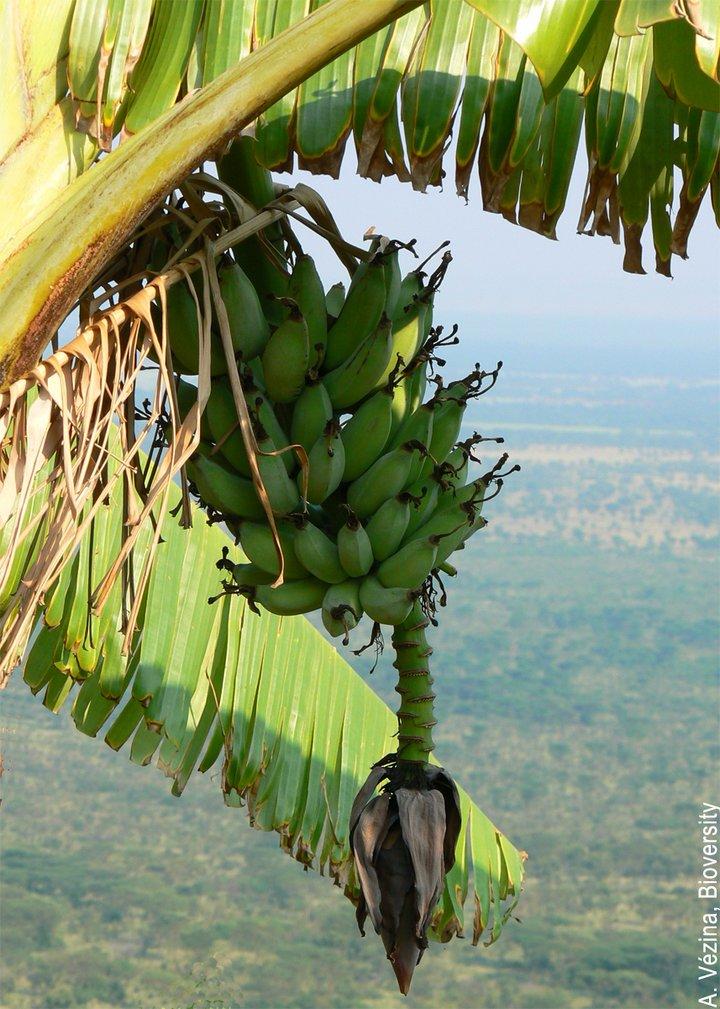CGIAR centres and research programmes combine forces to reduce the damage of banana disease in Uganda

Bioversity International brings together a highly multidisciplinary team with the aim of making innovative breakthroughs to curb the spread of Banana Xanthomonas Wilt while minimizing the costs.
Bioversity International brings together a highly multidisciplinary team with the aim of making innovative breakthroughs to curb the spread of Banana Xanthomonas Wilt while minimizing the costs.
Bananas and plantains (Musa spp.) provide a major source of food and income for over 30 million people in Eastern and Central Africa (ECA). Uganda produces an estimated 10 million tonnes annually valued at about US$550 million. Most ECA bananas are domestically consumed with the highest global per capita consumption of over 200 kg. Banana Xanthomonas Wilt (BXW), a bacterial disease, emerged in Uganda in 2001 and has since proved to have a devastating effect on banana production, with up to 100% loss if no management practices are adopted. To control the disease, farmers can adopt a package of practices, including single diseased stem removal and cleaning of tools to prevent contamination. Alternatively, resistant cultivars are under development. Several policy interventions are thus available but it is not clear which will have the greatest impact on curbing the spread of BXW while minimizing the costs.
Bioversity International, under the umbrella of the CGIAR Research Program on Roots, Tubers and Bananas, organized a workshop in Kampala, Uganda, 1–2 February 2018, to understand better the socio-economic impact of BXW spread and quantify the role of policy interventions. The goals of the workshop were to:
- Finalize and validate the conceptual framework describing relationships between different elements of BXW spread and its socio-economic consequences, linking different scales – from farm to country levels
- Finalize and validate research questions of the study
- Identify what data, methods and models are available and what resources are needed to fill in the missing elements
- Generate a framework for linking the models
- Formulate scenarios for simulation modeling, which would represent possible alternative future (until 2050) developments to inform policymakers
- Roadmap tasks and deliverables
The research will answer the question: What will be the socio-economic impact of BXW spread in Uganda until 2050 if there are no policy interventions, and under different interventions?
This highly complex question requires an integrated modelling approach which can be modelled to see the impact of different interventions on banana production, producers’ revenue, market prices, consumption and nutrition, and link them to costs for different actors, starting from the government and ending with farmers. To address such different areas of focus and implications at multiple scales, from the farm to (inter)national level, the research brings together a highly multidisciplinary team hailing from different CGIAR research centres, different disciplines (agronomists, economists, plant pathologists, mathematicians), different CGIAR research programmes (CRP), different flagships within the roots, tubers and bananas (RTB) CRP, together with representatives of Makerere University and the National Agricultural Research Organization of Uganda.
This innovative research links various models in order to understand the economic impact of pest and disease spread. We start with the dynamic global partial equilibrium model – IMPACT, developed by the International Food Policy Research Institute (IFPRI) with support from the CGIAR Research Program on Policies, Institutions and Markets (PIM). This is an economic simulation model for analysis of long-term agricultural markets and food security. A crop disease mapping model based on statistical analysis of survey data will be combined with a mathematical model for disease spread dynamics, in order to inform the IMPACT model about the dynamics of BXW spread and its consequences for yield loss. Additionally, we will systematically assess costs borne by different actors in the food system.
By combining expertise from RTB research clusters on resilient crops, banana bacterial wilt, improved livelihoods at scale, foresight and impact assessment, and sustainable intensification/ diversification, and linking those with the IMPACT model, we have the potential to make innovative breakthroughs that can truly make a difference in the management of the devastating BXW disease and defend Uganda’s economic base and food security.
Learn moreabout Banana Xanthomonas Wilt and how to control it.
This research is part of the CGIAR Research Program on Roots, Tubers and Bananas and is supported by CGIAR Fund Donors. Additional support, for the IMPACT modelling part was provided by the CGIAR Research Program on Policies, Institutions and Markets (PIM) through the Global Futures and Strategic Foresight project.
Photo: A shrivelled male bud is a symptom of Xanthomonas wilt. Credit: Bioversity International/A. Vezina (Retrieved from Musarama).
